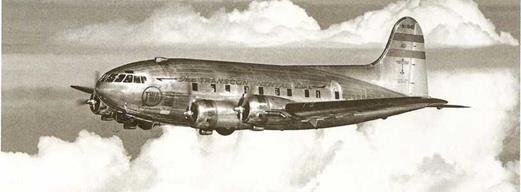Above the Weather


Up, Up, and Away
T. W.A. had been experimenting with high-altitude flying for most of the 1930s, ever since ex-Naval Lieutenant D. W. “Tommy” Tomlinson started serious work in 1934 with the Northrop Gamma (see page 27). During the two years 19351936, he was estimated to have done more flying (with oxygen equipment) at altitudes above 30,000 feet than all other pilots, military and civil, combined. His experience— in practical terms exclusive to T. W.A.—led to the conclusion that 95% of all weather problems occurred below 16,000 feet, so that an aircraft that flew at 20,000 feet would be much smoother in flight, and faster.
Improved Comfort Level
The full benefit that such an innovation brought to the airline clientele is sometimes forgotten. Unpressurized DC-3s, which were flying 85% of the airline mileage in the United States by 1940, were a great improvement over the old Fords; but they still had to fly at low altitudes and through weather that was too often very turbulent, mainly because of low
clouds that could not be avoided. The term “air pocket” was used to describe sudden, sometimes violent, changes of altitude, in which the aircraft would drop suddenly, and so would the passengers, except for their stomachs. Air sickness, rare today, was a common occurrence in the 1930s.
T. W.A. Does It Again
The introduction of the Boeing 307 Stratoliner, described on the opposite page, was the first commercial aircraft to incorporate cabin pressurization to eliminate the discomfort of low altitude flying. Even though the differential against sea level pressure was only 2-1/2 lb/square inch, this was enough to enable the 307 to cruise at 20,000 feet “above the weather.” Although on the transcontinental route, two stops still had to be made, and sometimes three, when T. W.A. inaugurated the service on 8 July 1940, it cut the coast-to-coast time to less than 14 hours, some four hours quicker than the DC-3’s. One of the economies for the airline was a marked decline in the budget allocated for the purchase of sick-bags, and, in those days, sick-cups.
|
|
|
|












